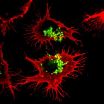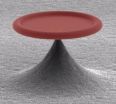(Press-News.org) A new breakthrough in the fight against pneumonia, meningitis and septicaemia has been announced today by scientists in Dublin and Leicester.
The discovery will lead to a dramatic shift in our understanding of how the body's immune system responds to infection caused by Streptococcus pneumoniae and pave the way for more effective vaccines.
The collaborative research, jointly led by Dr Ed Lavelle from Trinity College Dublin and Dr Aras Kadioglu from the University of Leicester, with Dr Edel McNeela of TCD as its lead author, has been published in the international peer-reviewed journal PLoS Pathogens.
The research was carried out by the teams from Dublin and Leicester with other collaborators from Trinity College Dublin, the U.S and Switzerland over four years and supported by Science Foundation Ireland, Enterprise Ireland, the Medical Research Council (MRC) and the Meningitis Research Foundation.
The two teams say they have shown for the first time that the bacterial toxin pneumolysin triggers an immune response by activating a recently discovered group of proteins, called the NLRP3 inflammasome. Once activated, the inflammasome provides protection against infection caused by this pathogen.
The Leicester and Dublin research groups demonstrated that this mechanism operates independently of other previously described immune response proteins - contrary to a dogma in the field.
Importantly, this paper is the first to demonstrate that the NLRP3 inflammasome is essential in the immune response against infection by the pathogen and that the bacterial toxin pneumolysin is the key driver of this process. The researchers state that this new knowledge of how the toxin interacts with the immune system will mean that new vaccines can be developed and targeted more effectively.
Describing the results as exciting, the researchers say it will potentially have a significant impact in the development of vaccines against pneumococcal disease.
Dr Lavelle, who is Lecturer in Immunology in the School of Biochemistry and Immunology, Trinity College Dublin, said: "This is a very exciting finding and supports the development of inflammasome activating vaccines to prevent pneumococcal diseases including pneumonia and septicaemia. If a protein based vaccine could be produced that can protect against all strains of the pneumococcus, this would be of tremendous value and our discovery that NLRP3 is needed for protection will point us in the right direction in terms of how to develop such vaccines."
Dr. Aras Kadioglu, Reader in Respiratory Infection in the Department of Infection, Immunity & Inflammation at the University of Leicester said: "This is a major breakthrough in our understanding of the immune response to Streptococcus pneumoniae; a human pathogen of global significance, responsible for over one million infant deaths annually and the major cause of illness and death in the elderly from infections of the respiratory tract. In order to develop improved pneumococcal vaccines for both the very young and the elderly, it is essential to understand how this bacterium interacts with the host immune system. The discoveries described in our paper represent a huge stride towards this objective. That is why these are exciting new findings, discovered in the course of a unique collaboration between scientists at the University of Leicester and Trinity College Dublin."
INFORMATION:
Citation: McNeela EA, Burke Á, Neill DR, Baxter C, Fernandes VE, et al. (2010) Pneumolysin Activates the NLRP3 Inflammasome and Promotes Proinflammatory Cytokines Independently of TLR4. PLoS Pathog 6(11): e1001191. doi:10.1371/journal.ppat.1001191
NOTE TO NEWSDESK:
PLEASE CITE TRINITY COLLEGE DUBLIN AND UNIVERSITY OF LEICESTER IN ANY REPORT
For more information contact:
At Trinity College Dublin
Dr Ed Lavelle
Lecturer in Immunology
School of Biochemistry and Immunology
Trinity College
Tel 01 8962488
Email: lavellee@tcd.ie
At University of Leicester
Dr. Aras Kadioglu,
Reader in Respiratory Infection
Department of Infection Immunity & Inflammation University of Leicester Tel 0116-2522947
Email: ak13@le.ac.uk
PRESS OFFICE CONTACTS:
Leicester: Ather Mirza, University of Leicester press office, 0116 252 3335; mobile 07711 927821 email pressoffice@le.ac.uk
Dublin: Caoimhe Ní Lochlainn, Trinity College Dublin Press Officer, tel: +353-1-8962310 mobile: +353-(0)87-99588014, email: communications@tcd.ie
Image available from pressoffice@le.ac.uk : A dendritic cell infected with Streptococcus pneumoniae (Courtesy of Edel McNeela and Jim Harris)
New vaccine hope in fight against pneumonia and meningitis
Dramatic advance in understanding of how the body fights bacteria paves way for more effective vaccines
2010-11-12
ELSE PRESS RELEASES FROM THIS DATE:
Scientists demystify an enzyme responsible for drug and food metabolism
2010-11-12
For the first time, scientists have been able to "freeze in time" a mysterious process by which a critical enzyme metabolizes drugs and chemicals in food. By recreating this process in the lab, a team of researchers has solved a 40-year-old puzzle about changes in a family of enzymes produced by the liver that break down common drugs such as Tylenol, caffeine, and opiates, as well as nutrients in many foods. The breakthrough discovery may help future researchers develop a wide range of more efficient and less-expensive drugs, household products, and other chemicals. The ...
Gene discovery suggests way to engineer fast-growing plants
2010-11-12
DURHAM, N.C. – Tinkering with a single gene may give perennial grasses more robust roots and speed up the timeline for creating biofuels, according to researchers at the Duke Institute for Genome Sciences & Policy (IGSP).
Perennial grasses, including switchgrass and miscanthus, are important biofuels crops and can be harvested repeatedly, just like lawn grass, said Philip Benfey, director of the IGSP Center for Systems Biology. But before that can happen, the root system needs time to get established.
"These biofuel crops usually can't be harvested until the second ...
Stanford scientists identify key protein controlling blood vessel growth into brains of mice
2010-11-12
STANFORD, Calif. — One protein single-handedly controls the growth of blood vessels into the developing brains of mice embryos, according to researchers at the Stanford University School of Medicine. Understanding how the protein, a cellular receptor, functions could help clinicians battle brain tumors and stroke by choking off or supplementing vital blood-vessel development, and may enhance the delivery of drugs across the blood-brain barrier.
"The strength and specificity of this receptor's effects indicate that it could be a very important target," said Calvin Kuo, ...
Fortify HIT contracts with education and ethics to protect patient safety, say informatics experts
2010-11-12
Bethesda, MD—An original and progressive report on health information technology (HIT) vendors, their customers and patients, published online today, makes ground-breaking recommendations for new practices that target the reduction or elimination of tensions that currently mar relationships between many HIT vendors and their customers, specifically with regard to indemnity and error management of HIT systems. In light of the Obama Administration's $19 billion investment in HIT, paid out in ARRA stimulus funds, these recommendations are particularly significant in helping ...
Graphene's strength lies in its defects
2010-11-12
PROVIDENCE, R.I. [Brown University] — The website of the Nobel Prize shows a cat resting in a graphene hammock. Although fictitious, the image captures the excitement around graphene, which, at one atom thick, is the among the thinnest and strongest materials ever produced.
A significant obstacle to realizing graphene's potential lies in creating a surface large enough to support a theoretical sleeping cat. For now, material scientists stitch individual graphene sheets together to create sheets that are large enough to investigate possible applications. Just as sewing ...
New analysis explains formation of bulge on far side of moon
2010-11-12
SANTA CRUZ, CA--A bulge of elevated topography on the farside of the moon--known as the lunar farside highlands--has defied explanation for decades. But a new study led by researchers at the University of California, Santa Cruz, shows that the highlands may be the result of tidal forces acting early in the moon's history when its solid outer crust floated on an ocean of liquid rock.
Ian Garrick-Bethell, an assistant professor of Earth and planetary sciences at UC Santa Cruz, found that the shape of the moon's bulge can be described by a surprisingly simple mathematical ...
Contact among age groups key to understanding whooping cough spread and control
2010-11-12
ANN ARBOR, Mich.---Strategies for preventing the spread of whooping cough---on the rise in the United States and several other countries in recent years---should take into account how often people in different age groups interact, research at the University of Michigan suggests.
The findings appear in the Nov. 12 issue of the journal Science.
Thanks to widespread childhood vaccination, whooping cough (pertussis) once seemed to be under control. But the illness, which in infants causes violent, gasping coughing spells, has made a comeback in some developed countries ...
Fruit flies lead scientists to new human pain gene
2010-11-12
Boston, Mass. - While it has become clear in recent years that susceptibility to pain has a strong inherited component, very little is known about actual "pain genes" and how they work. In the November 12th issue of Cell, researchers at Children's Hospital Boston and their collaborators report on a novel human pain gene. People with minor variations in this gene showed clear differences in susceptibility to acute heat pain and chronic back pain. Corroborating mouse studies give some clues as to how the gene controls pain sensitivity. The gene was uncovered in a genome-wide ...
All-optical transistor
2010-11-12
Controlling and modulating the flow of light is essential in today's telecommunications-based society. Professor Tobias Kippenberg and his team in EPFL's Laboratory of Photonics and Quantum Measurements have discovered a novel way to couple light and vibrations. Using this discovery, they built a device in which a beam of light traveling through an optical microresonator could be controlled by a second, stronger light beam. The device thus acts like an optical transistor, in which one light beam influences the intensity of another.
Their optical microresonator has two ...
Having severe acne may increase suicide risk
2010-11-12
Individuals who suffer from severe acne are at an increased risk of attempting suicide, according to a paper published on bmj.com today.
The study also finds that an additional risk may be present during and up to one year after treatment with isotretinoin, a commonly prescribed drug for severe acne. However, the authors stress that this additional risk is most likely due to the acne itself, rather than the drug treatment.
Isotretinoin (commonly marketed as Roaccutane, Accutane, Amnesteem, Claravis, Clarus or Decutan) has been used to treat severe acne since the 1980s. ...
LAST 30 PRESS RELEASES:
For teens, any cannabis use may have impact on emotional health, academic performance
School meals could unlock major gains for human and planetary health
Menopause hormone therapy does not appear to impact dementia risk
Signature patterns of brain activity may help predict recovery from traumatic brain injury
Dresden study uncovers new key mechanism in cancer cells
New species are now being discovered faster than ever before, study suggests
Cannabis-based products show limited short-term benefit for chronic pain, with increased risk of adverse effects
Cannabis products with more THC slightly reduce pain but cause more side effects
Clearing the brain of aging cells could aid epilepsy and reduce seizures
Brain injuries linked with potential risk of suicide, new study finds
New technique lights up where drugs go in the body, cell by cell
New study finds movement of fishing fleets can reveal shifts in marine ecosystems
Embargoed: New evidence points to potential treatment for vascular dementia
Study uncovers disrupted brain balance in alcohol dependence
Working in groups can help Republicans and Democrats agree on controversial content moderation online
Structural findings reveal how distinct GPCR ligands create different levels of activation
Anything-goes “anyons” may be at the root of surprising quantum experiments
UC review: Maximizing workplace opportunity for veterans
From generation to complex control: Metasurfaces make perfect vortex beams "within reach"
Thin-film lithium niobate-based detector: recent advances and perspectives
Exploring why some people may tend to persistently make bad choices
How cells balance their protein levels
Nirsevimab vs RSVpreF vaccine for RSV–related hospitalization in newborns
Effectiveness and impact of maternal RSV immunization and nirsevimab on medically attended RSV in US children
AI gives scientists a boost, but at the cost of too many mediocre papers
Next-generation vision model maps tree growth at sub-meter precision
Genes aren’t destiny for inherited blindness, study shows
MIT study: High-fat diets make liver cells more likely to become cancerous
Exposure to multiple fine particulate matter components and incident depression in the US Medicare population
Risk of burdensome health care spending over time in the US
[Press-News.org] New vaccine hope in fight against pneumonia and meningitisDramatic advance in understanding of how the body fights bacteria paves way for more effective vaccines



